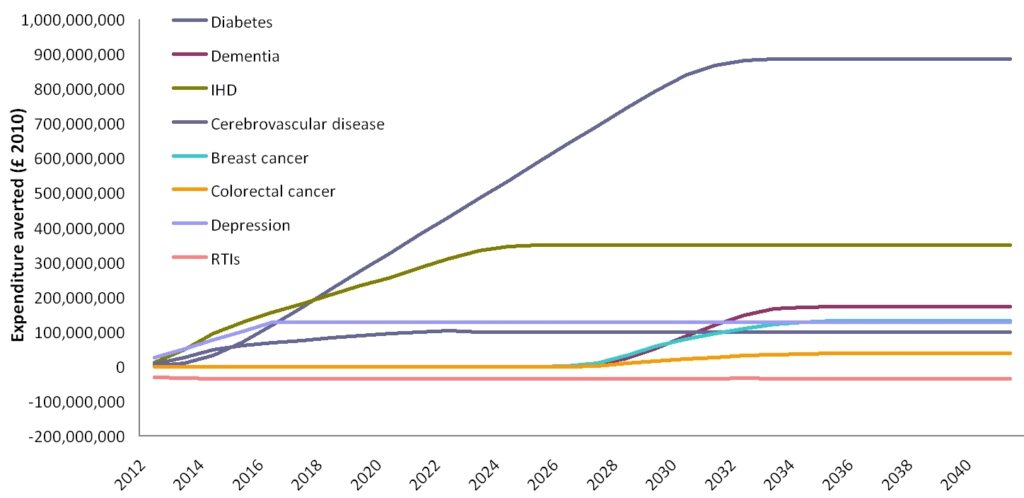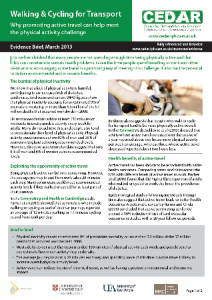How promoting active travel can help meet the physical activity challenge – March 2013
It is well established that many people are not spending enough time being physically active and that this can contribute to serious health problems. Given the time people spend travelling to work and other destinations, encouraging active travel is a promising way of meeting this challenge. It also has the potential to deliver environmental and economic benefits.
Jump to:
- Burden of physical inactivity
- Exploiting the opportunity of active travel
- Health benefits of active travel
- Carbon impact
- Modelling health and environmental impact
- Economic impact
- Policy implications
- References and resources
The burden of physical inactivity
We know that a lack of physical activity is harmful, contributing to an increased risk of type 2 diabetes, cardiovascular disease and cancer. WHO figures show that physical inactivity accounts for an estimated 9% of premature mortality, or more than 5.3 million of the 57 million deaths that occurred worldwide in 2008. (See also The Lancet series on Physical Activity.)
UK recommendations advise at least 150 minutes of moderate intensity aerobic activity every week for adults. Many do not achieve this, and people also tend to overestimate their level of physical activity. Physical activity questionnaires show 40% of men and 28% of women in England achieving recommended levels. However, objective accelerometer data suggest that only 6% of men and 4% of women achieve recommended levels (pdf, p13).
Exploiting the opportunity of active travel
Being physically active can be time consuming. However, the average journey to and from work takes 28 minutes each way. Many commuters could meet recommended activity levels if they walked or cycled for at least part of their journeys.
In the Commuting and Health in Cambridge study, Panter et al (2013) showed that commuters who include walking or cycling as part of their car journeys reported an average of 12 minutes walking or 17 minutes cycling to and from work per day.
Evidence also suggests that people who walk or cycle for transport tend to be more physically active overall. In the iConnect study, Sahlqvist et al (2013) showed that adults whose active travel increased over the course of a year reported about two hours more physical activity per week on average, whereas those whose active travel decreased reported about two hours less.
Health benefits of active travel
Active travel has been shown to be associated with better health outcomes. Comparing states and cities across the USA with different levels of active travel to work, Pucher et al (2010) found that the higher the proportion of adults who walked or cycled to work, the lower the prevalence of type 2 diabetes.
Epidemiological studies following individuals through time also suggest that active travel leads to better health outcomes. A systematic review by Hamer and Chida (2008) concluded that active commuting conferred around a 10% reduction in risk of cardiovascular outcomes in studies with 5-20 year follow-up periods.
Carbon impact
Cutting carbon emissions is an obvious benefit of reducing car travel. Goodman et al (2012), in the iConnect study, found that those who walked or cycled more for transport had lower carbon emissions overall. However, those who reported higher levels of recreational physical activity tended to generate higher transport carbon emissions, reflecting the fact that motor vehicles may often be used to travel to places to be active.
Modelling health and environmental impact
One of the ways CEDAR examines the impact of active travel is by using modelling tools which simulate the health impacts of changes in travel behaviours over time. Two studies from 2013 – Woodcock et al, Maizlish et al – used the ITHIM modelling tool to estimate the likely effects of a range of future scenarios for England & Wales, and for California.
The UK study used three scenarios involving more active travel developed by the Visions 2030 project www.visions2030.org.uk. Even the most conservative of these scenarios produced reductions in a range of diseases, including reducing the burden of heart disease and stroke by over 7%, and dementia by 5% .
The model suggested road traffic injuries would fall in the UK, in large part due to the substantial reductions in motor vehicle traffic and speed. The US study predicted an increase in injuries, but this was more than outweighed by the other health gains from the increase in physical activity.
Economic impact
A modelling study by Jarrett et al (2012) estimated the NHS costs that could be averted by a large shift towards active travel in England and Wales.

A shift now in walking from 0.6 km/day to 1.6 km/day, and in cycling from 0.4 km/day to 3.4 km/day (similar to current levels in Copenhagen) could result in changes in the costs of treating eight health conditions related to physical activity.
The study estimated that over 20 years, the expenditure averted would be over £17 billion (see graph right).
Policy implications
- Interventions that promote active travel have the potential to bring health, environmental and economic benefits.
- Healthy lives, healthy people: a call to action on obesity in England (Dept of Health 2011) states: “the 21st century environment often makes it hard to make the healthy choice. The job for Government and its partners at national and local level is to transform the environment so that it is less inhibiting of healthy lifestyles.” Interventions that promote active travel fit this aspiration.
- Many people make everyday journeys that could be walked or cycled at least in part, so interventions to encourage active travel have the potential to reach a large proportion of the population.
- With their public health and transport responsibilities, local authorities are ideally placed to implement interventions to promote active travel.
References and resources
CEDAR references
- The iConnect study aims to evaluate changes in travel, physical activity and carbon emissions related to Sustrans’ Connect2 programme. www.mrc-epid.cam.ac.uk/research/studies/iconnect
- Commuting and Health in Cambridge looks at how people travel and how this is related to their overall physical activity, health and wellbeing. www.mrc-epid.cam.ac.uk/research/studies/commuting-and-health-in-cambridge
- (ITHIM) Integrated Transport and Health Impact Modelling Tool provides integrated health impact assessment of transport policies and scenarios through changes in physical activity, road traffic injury risk, and urban air pollution. It is being used in a number of studies to estimate the health impact of scenarios, compare the impact of travel patterns in different places, and model the impact of interventions. www.mrc-epid.cam.ac.uk/research/research-areas/public-health-modelling/ithim
- Financial Incentives to Promote Active Travel: An Evidence Review and Economic Framework (Martin et al 2012) argues that financial incentives may have a larger role in promoting walking and cycling than has been previously acknowledged.
NICE resources
- The NICE Guidance, Walking and cycling: local measures to promote walking and cycling as forms of travel or recreation.
- NICE local government public health briefing on walking and cycling.
Other references
- Take action on active travel: Why a shift from car-dominated transport policy would benefit public health (pdf) From the Faculty of Public Health.
- WHO/Europe Health Economic Assessment Tool (HEAT) www.heatwalkingcycling.org This tool is designed to help you conduct an economic assessment of the health benefits of walking or cycling by estimating the value of reduced mortality that results from specified amounts of walking or cycling.
- Physical activity and health – facts and figures from Sustrans.
Please cite this Evidence Brief as: UKCRC Centre for Diet and Activity Research (CEDAR), Evidence Brief 4: Walking & Cycling for Transport – How promoting active travel can help meet the physical activity challenge – March 2013. www.mrc-epid.cam.ac.uk/resources/policy-resources/evidence-briefs/eb-why-active-travel-web

 MRC Epidemiology Unit
MRC Epidemiology Unit